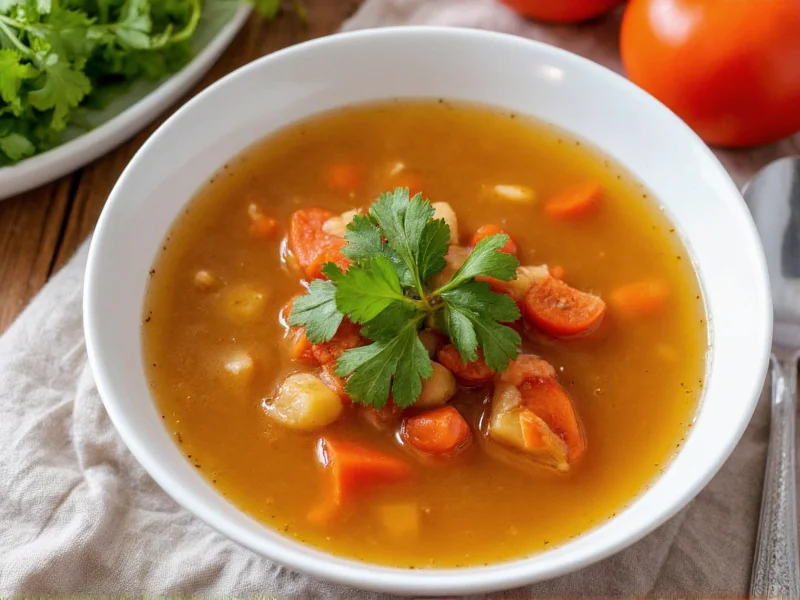Creating exceptional vegetable soup starts with understanding how vegetable broth transforms ordinary ingredients into a deeply flavorful dish. Unlike water-based soups, vegetable broth contributes complex umami notes and aromatic depth that elevate the entire recipe. The best vegetable soups balance texture, flavor layers, and nutritional density through careful ingredient selection and proper cooking techniques.
Why Vegetable Broth Makes Superior Soup
Using quality vegetable broth instead of water creates fundamental improvements in your soup's profile. Vegetable broth contains natural glutamates from ingredients like mushrooms, tomatoes, and onions that trigger umami receptors, making the soup taste richer and more satisfying. When preparing easy vegetable soup recipe with vegetable broth, the base liquid significantly impacts both flavor complexity and nutritional value.
Homemade vegetable broth typically outperforms store-bought versions in flavor depth, but quality commercial broths have improved dramatically in recent years. Look for low-sodium options without artificial flavors when selecting vegetable broth for soup recipes. The ideal broth should have a clear vegetable-forward taste without overpowering sweetness or saltiness.
Essential Ingredients for Flavorful Vegetable Soup
The foundation of any excellent homemade veggie soup with vegetable stock includes these components:
| Ingredient Category | Key Examples | Purpose |
|---|---|---|
| Aromatic Base | Onions, carrots, celery, garlic | Creates flavor foundation through caramelization |
| Flavor Enhancers | Tomato paste, mushrooms, dried seaweed | Adds umami depth and complexity |
| Main Vegetables | Root vegetables, greens, beans | Provides texture, nutrition, and heartiness |
| Finishing Elements | Fresh herbs, lemon juice, olive oil | Brightens flavors and adds freshness |
Step-by-Step Preparation Guide
Follow these professional techniques for the best vegetables for vegetable soup preparation:
- Sweat aromatics: Cook onions, carrots, and celery in olive oil over medium heat until softened (8-10 minutes). Avoid browning for cleaner vegetable flavors.
- Build flavor layers: Add tomato paste and cook for 2 minutes until it darkens slightly, then incorporate minced garlic and dried herbs.
- Add liquid properly: Pour in vegetable broth gradually, scraping the bottom to incorporate flavorful browned bits.
- Simmer strategically: Add hard vegetables first (potatoes, carrots), then softer vegetables (zucchini, greens) in stages to maintain ideal texture.
- Finish with brightness: Stir in fresh herbs and a splash of acid (lemon juice or vinegar) just before serving to elevate all flavors.
Avoiding Common Vegetable Soup Mistakes
Many home cooks make these errors when preparing vegetable soup recipe for beginners:
- Overcooking vegetables: Add delicate vegetables like spinach or peas during the last 5 minutes of cooking
- Underseasoning: Season in layers—add salt when sweating aromatics, again with broth, and final adjustment before serving
- Using low-quality broth: Even with fresh vegetables, poor broth makes soup taste flat
- Skipping the acid finish: A touch of lemon juice or vinegar balances richness and brightens flavors
Nutritional Benefits of Vegetable Soup
A well-constructed nutritious vegetable soup with vegetable stock delivers impressive health benefits. One serving typically provides:
- 30-50% of daily vitamin A needs from carrots and sweet potatoes
- 25-40% of vitamin C requirements from bell peppers and tomatoes
- 6-10 grams of dietary fiber supporting digestive health
- Only 150-250 calories per serving when prepared without added fats
The combination of fiber, vitamins, and hydration makes vegetable soup particularly valuable during cold seasons or when recovering from illness. Unlike meat-based broths, vegetable versions contain no saturated fats while delivering phytonutrients from diverse plant sources.
Variations for Dietary Needs
Adapt this healthy vegetable soup with homemade broth for various dietary requirements:
- Protein boost: Add white beans, lentils, or chickpeas for vegetarian protein
- Gluten-free: Naturally gluten-free when using certified broth (check labels)
- Vegan version: Ensure broth contains no honey or dairy derivatives
- Low-sodium option: Use homemade broth and increase herbs instead of salt
Storage and Reheating Tips
Proper storage maintains quality of your vegetable soup recipe with vegetable stock:
- Cool soup completely before refrigerating (within 2 hours of cooking)
- Store in airtight containers for up to 5 days in the refrigerator
- Freeze in portion-sized containers for up to 3 months
- Reheat gently on stove—avoid boiling which can break down vegetable textures
- Add fresh herbs after reheating for maximum flavor impact
Frequently Asked Questions
- Can I use water instead of vegetable broth in veggie soup?
Yes, but vegetable broth significantly enhances flavor. If using water, compensate by adding extra aromatics like onions, garlic, and celery, plus 1-2 tablespoons of tomato paste and dried mushrooms to create depth. The soup will lack the complexity that properly made vegetable broth provides. - How do I prevent my vegetable soup from becoming mushy?
Add vegetables in stages based on cooking time. Start with hard vegetables like carrots and potatoes, then add medium vegetables like zucchini 10 minutes later, and delicate greens during the last 5 minutes. Avoid overcooking and never boil vigorously—simmer gently instead. - What's the best way to store homemade vegetable broth?
Cool broth completely before storing. Refrigerate for up to 5 days or freeze in portion-sized containers for up to 6 months. For freezer storage, leave 1-inch headspace for expansion. Ice cube trays work well for freezing small portions that can be transferred to bags once frozen. - Which vegetables should I avoid in vegetable soup?
Some vegetables don't perform well in soups: cabbage (can become sulfurous), broccoli stems (remain tough), and pre-cooked frozen vegetables (become mushy). Stick to vegetables that maintain texture during simmering like carrots, potatoes, beans, and hearty greens. Add delicate vegetables like peas at the very end. - How can I make vegetable soup more filling without adding meat?
Incorporate protein-rich legumes like lentils, chickpeas, or white beans. Add whole grains such as barley or quinoa during the last 15 minutes of cooking. For creaminess without dairy, blend a portion of the soup or add pureed cannellini beans. These additions increase satiety while maintaining the vegetarian integrity of your soup.











 浙公网安备
33010002000092号
浙公网安备
33010002000092号 浙B2-20120091-4
浙B2-20120091-4